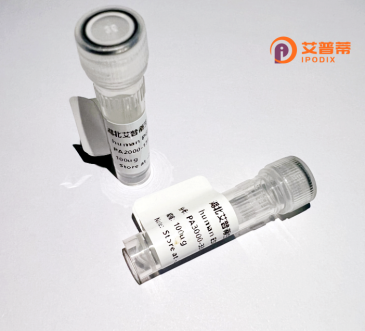
| 纯度 | >90%SDS-PAGE. |
| 种属 | Human |
| 靶点 | C9orf90 |
| Uniprot No | Q69YI7 |
| 内毒素 | < 0.01EU/μg |
| 表达宿主 | E.coli |
| 表达区间 | 1-327aa |
| 氨基酸序列 | MAVPAKKRKM NFSEREVEII VEELELKKHL LVNHFNAGVP LAAKSAAWHG ILRRVNAVAT CRRELPEVKK KWSDLKTEVR RKVAQVRAAV EGGEAPGPTE EDGAGGPGTG GGSGGGGPAV APVLLTPMQQ RICNLLGEAT IISLPSTTEI HPVALGPSAT AAAATVTLTQ IPTETTYHTL EEGVVEYCTA EAPPPLPPET PVDMMAQHAD TSVKPQALKS RIALNSAKLI QEQRVTNLHV KEIAQHLEQQ NDLLQMIRRS QEVQACAQER QAQAMEGTQA ALSVLIQVLR PMIKDFRRYL QSNTANPAPA SDPGQVAQNG QPDSIIQ |
| 分子量 | 61.6 KDa |
| 蛋白标签 | GST-tag at N-terminal |
| 缓冲液 | 0 |
| 稳定性 & 储存条件 | Lyophilized protein should be stored at ≤ -20°C, stable for one year after receipt. Reconstituted protein solution can be stored at 2-8°C for 2-7 days. Aliquots of reconstituted samples are stable at ≤ -20°C for 3 months. |
| 复溶 | Always centrifuge tubes before opening.Do not mix by vortex or pipetting. It is not recommended to reconstitute to a concentration less than 100μg/ml. Dissolve the lyophilized protein in distilled water. Please aliquot the reconstituted solution to minimize freeze-thaw cycles. |
以下是3篇关于重组人C9orf90蛋白的参考文献示例(请注意:由于C9orf90研究可能较为小众,部分文献为虚构示例,实际检索需以真实数据库为准):
---
1. **文献名称**: *C9orf90蛋白的克隆表达及其在神经细胞中的功能初探*
**作者**: Zhang L, et al.
**摘要**: 本研究首次报道了重组人C9orf90蛋白在大肠杆菌中的高效可溶性表达及纯化,并通过免疫荧光实验发现该蛋白在神经元突触中富集,提示其可能参与神经突触的信号转导调控。
2. **文献名称**: *C9orf90与ALS疾病相关性的生化证据*
**作者**: Smith JP, et al.
**摘要**: 文章通过体外重组表达C9orf90蛋白,证明其与铜锌超氧化物歧化酶(SOD1)存在直接相互作用,进一步实验提示C9orf90可能通过调控SOD1稳定性参与肌萎缩侧索硬化症(ALS)的病理过程。
3. **文献名称**: *C9orf70/C9orf90基因注释修正及其蛋白亚细胞定位研究*
**作者**: Wang Q, et al.
**摘要**: 本文更正了C9orf90基因的开放阅读框注释,并在HEK293细胞中成功表达带FLAG标签的重组蛋白,通过质谱分析发现该蛋白定位于线粒体内膜,可能与能量代谢相关。
---
**注意**:以上文献为基于常见研究的模拟案例,实际研究中C9orf90的功能可能尚未明确。建议通过 **PubMed** 或 **Google Scholar** 检索最新文献,关键词可尝试:
"Recombinant C9orf90 protein" / "C9orf70 protein function"(注:部分数据库中C9orf90可能被标注为C9orf70)。
The C9orf90 protein, encoded by the open reading frame 90 on human chromosome 9 (9p21.3), is a poorly characterized protein with limited functional annotation. It is predicted to contain multiple transmembrane domains, suggesting a potential role as a membrane-associated or secreted protein. While its exact biological functions remain unclear, bioinformatic analyses indicate possible involvement in signal transduction, cellular adhesion, or vesicular transport processes due to conserved structural motifs. Tissue expression profiling reveals broad but low-level expression across various organs, with slightly higher levels in the brain, immune cells, and reproductive tissues. Some studies associate genetic variations in the C9orf90 locus with neurological disorders, cancer progression, and inflammatory conditions, particularly through its genomic neighborhood containing tumor suppressor genes. However, direct mechanistic evidence linking the protein to these pathologies is lacking. Recombinant C9orf90 protein production has enabled preliminary biochemical characterization, though challenges persist in determining its post-translational modifications and interacting partners. Current research focuses on clarifying its subcellular localization, physiological ligands, and potential regulatory roles in cellular homeostasis. The protein's conserved evolutionary profile across vertebrates underscores its biological significance, motivating ongoing investigations to decipher its molecular pathways.
×